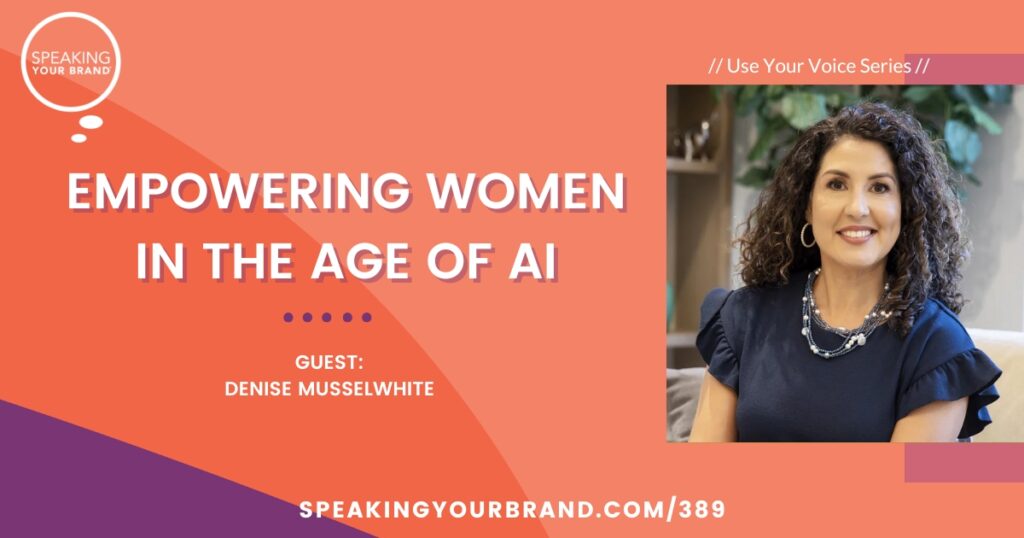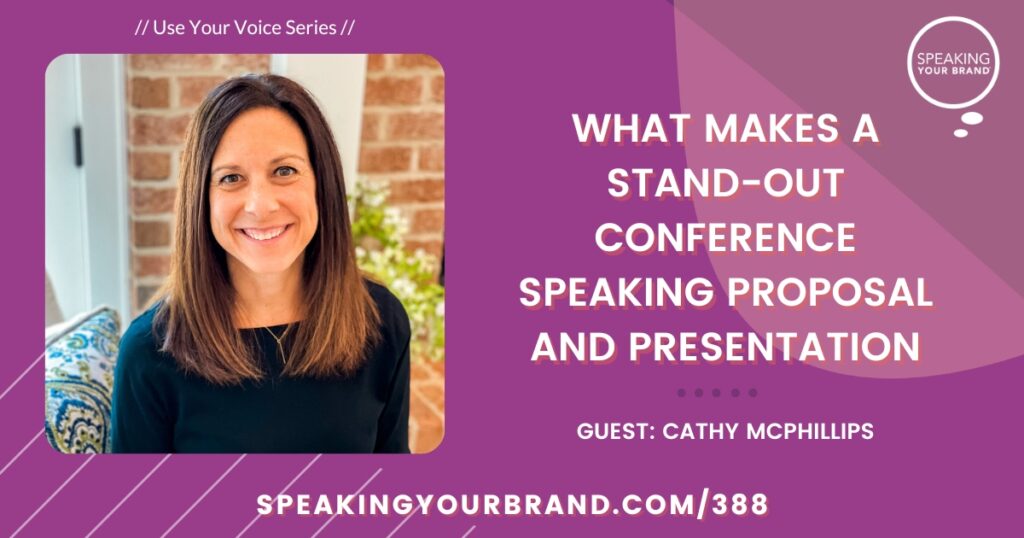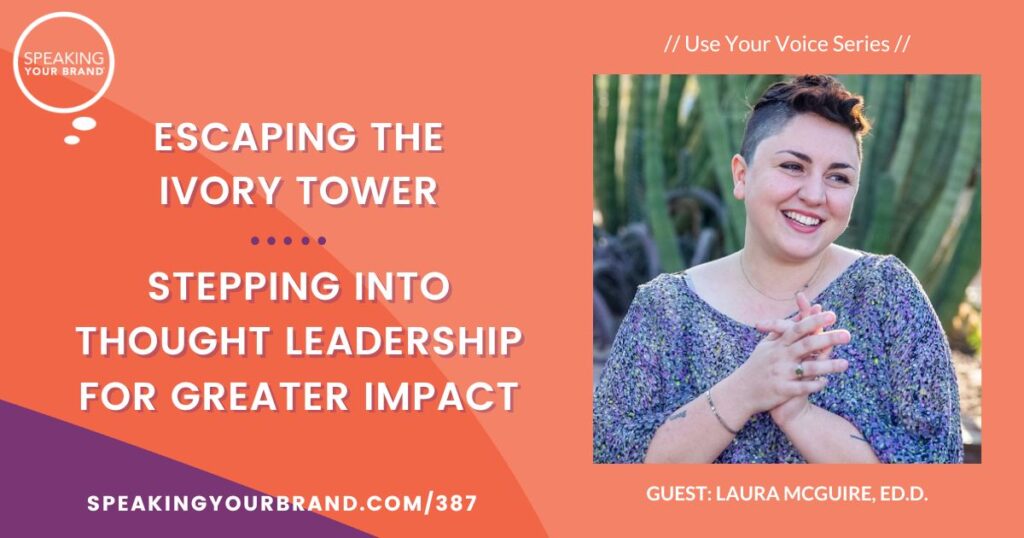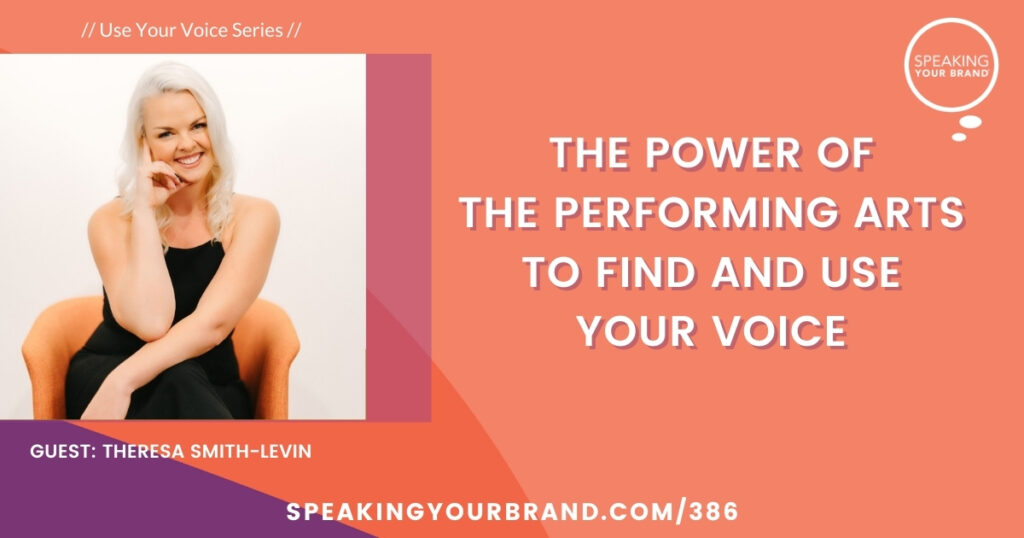3 Types of Thought Leadership Models with Carol Cox: Podcast Ep. 233
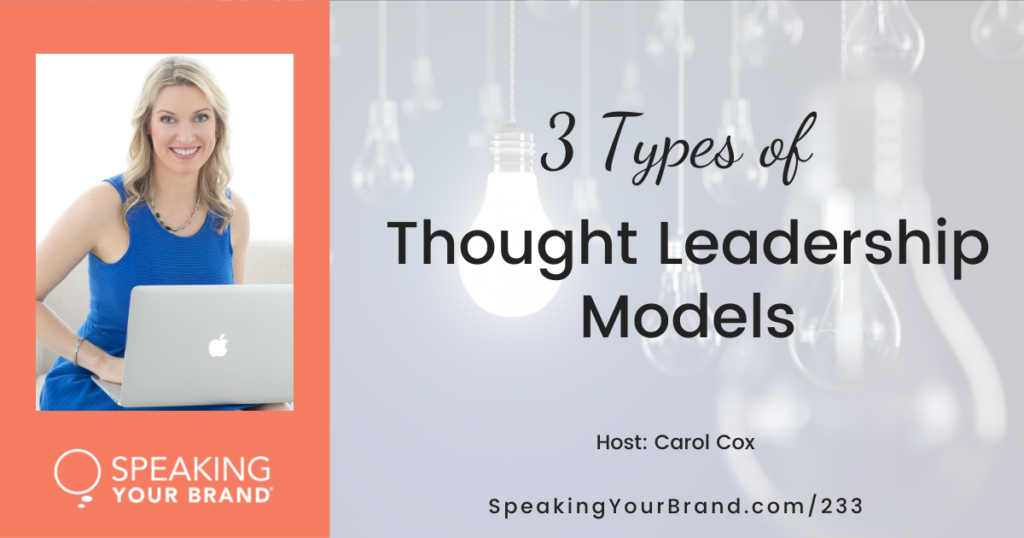
Subscribe to the podcast!
If you’re like many of the women we work with, you’re an expert in what you do.
Clients value the work you do for them and you’re good at it.
You provide useful presentations and trainings for your audiences.
AND you know there’s a bigger impact you want to make.
You’d like to position yourself as a thought leader, but perhaps you’re not sure what exactly that means or how to do it.
In this episode, I share 3 types of thought leadership models.
A lot of times we see someone who we would categorize as a thought leader and think that we can’t do what they do – and you don’t have to be just like them.
You can see which of these 3 types most closely aligns with who you naturally are.
Just like your business model influences your customer segments, value proposition, key activities, and channels, your thought leadership model will do the same.
Once you have an understanding of which type of thought leader you are, your goals, your message, your content, and your platforms will be much clearer and easier to implement.
In addition to listening to this episode in your favorite podcast app, you can also watch it on YouTube.
While you’re there, be sure to Subscribe to our YouTube channel. We’re going to be adding more videos!
About Us: The Speaking Your Brand podcast is hosted by Carol Cox. At Speaking Your Brand, we help women entrepreneurs and professionals clarify their brand message and story, create their signature talks, and develop their thought leadership platforms. Our mission is to get more women in positions of influence and power because it’s through women’s stories and visibility that we challenge the status quo and change existing systems. Check out our coaching programs at https://www.speakingyourbrand.com.
Links:
Show notes at https://www.speakingyourbrand.com/233.
Download our FREE workbook on how to position yourself as a thought leader: https://www.speakingyourbrand.com/guide/.
Get on the interest list for our Thought Leader Academy: https://www.speakingyourbrand.com/academy/
Schedule a consult call to talk about creating your signature talk and thought leadership platform: https://www.speakingyourbrand.com/contact.
Connect on social:
- Carol on LinkedIn = https://www.linkedin.com/in/carolcox
- Carol on Instagram= https://www.instagram.com/carolmorgancox
Related Podcast Episodes:
- Episode 213: The V.O.I.C.E. of Thought Leaders with Carol Cox [Big Ideas Series]
- Episode 229: 3 Speaking Styles You Can Use
- Episode 232: Are You an Influencer, an Expert, or a Thought Leader? with Carol Cox
233-SYB-Types-of-Thought-Leaders.mp3: Audio automatically transcribed by Sonix
233-SYB-Types-of-Thought-Leaders.mp3: this mp3 audio file was automatically transcribed by Sonix with the best speech-to-text algorithms. This transcript may contain errors.
Carol Cox:
I've identified three types of thought leadership models to make it easier for you to understand what kind of content to create and where to show up. Listen in to episode 233 of the Speaking Your Brand podcast.
Carol Cox:
More and more women are making an impact by starting businesses, running for office and speaking up for what matters. With my background as a TV political analyst, entrepreneur and speaker, I interview and coach purpose driven women to shape their brands, grow their companies, and become recognized as influencers in their field. This is speaking your brand, your place to learn how to persuasively communicate your message to your audience.
Carol Cox:
Hi there and welcome to the Speaking Your Brand podcast. I'm your host, Carol Cox. Last week I did an episode called are you an influencer, an expert or a thought leader? Influencers say to their audiences, be like me, those are the Kim Kardashians in the celebrity realm, or like the Marie Forleo's and the Amy Porterfield's in the business and marketing realm, experts say to their audiences, learn from me. Those are academics, professors and really us as entrepreneurs, as service providers were experts in what we do. Thought leaders say to their audiences. Imagine with me. So I talked about in that episode that if you're like many of the women we work with, you're an expert in what you do. Clients value the work that you do for them, and you're really good at it, and you provide useful presentations and trainings for your audiences.
Carol Cox:
And yet, you know, there's a bigger impact that you want to make, a bigger message that you want to share. So you like to position yourself as a thought leader, but perhaps you're not sure what exactly that means or how to do it. So I talked about that in last week's episode, and we're going to dive deeper in today's episode. And by the way, I hear from people, especially women, and I see this in articles online and in other podcasts and videos and on social media that a lot of people don't like the Terme thought leader or don't want to call themselves thought leader. And that is totally fine. You can use whatever terms you like. You can use no terme at all. You don't have to put it on your website that you're a thought leader, or put it on your LinkedIn profile. The reason I use the Terme thought leader and thought leadership is because of my long background in marketing. I know it's best to use the terms that people are familiar with and what they search on. Hence, I use the words thought leadership, speaking, signature talk, and so on. So you can definitely decide whatever terms you feel applies to you. The other thing that I see a lot online is that people are not sure if they can decide that they want to be a thought leader, or if other people decide for you. So other people call you a thought leader, but you can't call it it yourself, or you can't decide to be a thought leader.
Carol Cox:
And I believe 100% that you can definitely decide to be a thought leader through the message and the content that you share and the content that you create. So that's why we're really diving into this idea of thought leadership in these podcast episodes. So in this episode, I'm going to share three types of thought leadership models. And a lot of times we see someone who we would categorize as a thought leader and think that we can't do what they do. And it may be because they have a different thought leadership model than what feels natural to you, or the one that would best fit you. So as you listen to this episode, look at these three types and decide which one most closely aligns with who you naturally are and which one that you would like to think about using for yourself. Because once you have an understanding of which type of thought leader you are, your goals, your message, your content, your platforms that you're going to show up on will be so much clearer, and it's going to be so much easier to implement that into your strategy. And if you're new to speaking your brand, welcome. So glad to have you here. We help women entrepreneurs and professionals clarify their brand message and story, create their signature talks, and of course, develop their thought leadership platforms. Our mission is to get more women in positions of influence and power because we know is through women's stories, voices and visibility that we challenge the status quo and change existing systems.
Carol Cox:
You can check out our coaching programs on our website at Speaking Your Brand. Com. We work with our clients one on one as well as in our Thought Leader Academy, which is enrolling again in September. You can get on the interest list and get all the details by going to speaking your brand.com/academy. Again, that's speaking your brand.com/academy. Now let's get on with the show. I think of these thought leadership models like business models. I've been teaching business models and entrepreneurship at a university since 2009, and the beauty of understanding your business model is that it then influences your target market, your customer segments, the value proposition for those customer segments, the key activities you need to do in your business, the channels and the customer relationships that you have, and much more. And so likewise, understanding your thought leadership model will also influence where you show up. So what platforms? What channels? You show up on what kind of content to create and how you are just showing up as yourself. So let's take a look now at these three thought leadership models. The first thought leadership model is personality driven. So the symbol for this is a spotlight. So think of a spotlight. When your thought leadership model is personality driven the spotlight is on that particular person. All eyes are on them. If we think of people like Gary Vaynerchuk, Tony Robbins again, Marie Forleo, Amy Porterfield now, I mentioned in last week's episode that I would put them in the influencer category.
Carol Cox:
Some people maybe would consider them thought leaders in their space, and if that is so, then I would definitely put them in the personality driven thought leadership model. But if you think about this type of thought leadership model being personality driven, they ask their audiences, who do you want to be? So it's again, it's very similar to influencers in the sense that it's like the be like them. It's aspirational. It's about the individual. And again, that spotlight is on them. So the focus is on that particular thought leader's personality, the work that they do, their lifestyle, the words that they use. And so examples in definitely the thought leadership space for sure would be an entrepreneur like Rachel Rogers. She recently came out with her book called We Should All Be Millionaires. Her company and her podcast are called hello seven, and in her podcast, and definitely on her social media and in her email content, it's really focused around her. So her work, her lifestyle, her words and what she is doing now. There is nothing wrong with a personality driven thought leadership model. There is none of these are better or worse than the other. There is no judgment here. It's really about what is your natural style? Where do you feel best showing up? And for Rachel Rogers, she has that charisma, she has that personality.
Carol Cox:
She has that energy that she inspires other people through the work that she does, through her lifestyle and through the messages that she shares. And so what it looks like with these personality driven thought leaders, it is very similar to influencers. They tend to have larger audiences and they also tend to have mass market products. Rachel Rogers is a great example of this. Prior to kind of mid 2020, her business model was very much focused on high end. So she had high end masterminds and coaching programs that she would run that would cost maybe $25,000 a year to participate in. And then when the pandemic happened, and then the Black Lives Matter protest resurgence after George Floyd's murder at the end of May, she and her company opened up what they call the club. We should all Be millionaires. The club, which is a more of a mass market product, I think it's 250 or $300 per month, so definitely much less expensive than the previous business model that she had. So she is definitely going after this larger audience and the message from personality driven thought leaders is very aspirational. It's future focused. Again, it's this question who do you want to be? And it's about individual change. So the content that they create is podcasts video. They will oftentimes run events or run retreats so they can look someone like Tony Robbins. They offer practical exercises. So like a skill transfer. So they're helping you do something specific within your business or within your life.
Carol Cox:
They also talk a lot about mindset. So mindset shifts and what's, you know, limiting beliefs that are maybe keeping you back. They share inspirational quotes. So it is very aspirational and inspirational. And again think of this symbol of the spotlight. All eyes are focused on them. So the other people who are involved in their company, in their organization, tend to be support staff because they tend to be the one face and voice of the brand and of their business. Now, the second type of thought leadership model is research driven, and the symbol for that is a mirror. So it's a reflection. So the thought leader says to their audiences, who are you and why? And really for research driven thought leaders, they are putting that mirror up because they are talking about themselves through their research, but really they are a reflection for their audience. And the people that I think of who are research driven thought leaders are Brene Brown, Simon Sinek, also Tara McMullen of the Wetworks podcast. She also has a community called Wetworks. I was on her podcast back in 2019, and she was on the Speaking Your Brain podcast also in 2019, and she has really found her voice around her thought leadership message, especially in the past year. And it is very research driven. She's taken all of the things that she has seen, the clients and entrepreneurs that she works with and that are in her network and has started really thinking about the big picture of what it means to run a business and, and really helping people to question their assumptions.
Carol Cox:
So the focus of research driven thought leaders is around their research, their ideas, and how their own journey and experiences have influenced their ideas and perspectives. And so in last week's episode, I talked about experts. So experts have ideas, but they're very much related to the research they do and to their area of expertise. What differentiates experts from thought leaders is that thought leaders put themselves into their ideas, into their research. They share their own journey, their own stories with their audiences. And so what it looks like for the research driven thought leaders is that they tend to have more niche audiences that are perhaps business minded or academic, and so they are really helping their audiences understand themselves better. They look at the past and the present, and they're really focused on both individual and organizational change. So if we think back to that personality driven thought leadership model, the first one is that it's very future focused, is very aspirational, and it's really focused on the individual, research driven thought leaders look at the past and the present. So who are you? How did you get to where you are today as a person and why? And then they're looking at the present. So how do you show up today? And they also help both individuals and organizations. If you think of Brené Brown and Simon Sinek, they help a lot of companies navigate the changes that are going on.
Carol Cox:
Of course, it's at the individual level, but it's very much they do training and events for organizations as well. So the kind of content that research driven thought leaders create are books, trainings, frameworks. They help individuals or organizations apply their learnings. Most of them have podcasts. They maybe create video content and Ted talks and things like that. So who else is involved with them is that unlike personality driven thought leaders, which the spotlight is pretty much solely on them? With research driven thought leaders, they train others based on their framework, based on their their research and their ideas. So it's not just about them. They very much have training as part of their business model, as part of their thought leadership model. Now, of course, Brene Brown and Simon Sinek and Tara McMullen are still the face and the voice of their brand, of their business. But it's not just about them. They also train others in what they do. And again, there's no judgment here. It's not that one thought leadership model is better than the other. Just like one business model is not better than the other. It's just what fits best with who you are and what you want your business and thought leadership to do. So. Remember, the first thought leadership model was personality driven and that symbol is the spotlight. The second thought leadership model is research driven and that symbol is the mirror.
Carol Cox:
So holding that mirror up for individuals and organizations. Now the third thought leadership model is mission driven mission driven. And this symbol is a magnifying glass. So mission driven thought leaders help people look deeper to kind of magnify and see something that they maybe haven't noticed before. They really have a bigger vision for society and for social change. And they ask their audiences, who can we become? So it's not about the individual, it's about the collective. It's about a large group of people, a community, and really an entire society. And if we think of examples, the ones that come to mind for me are the three women who started the Black Lives Matter movement Alicia Garza, Patrisse Cullors and Opal Tometi. Think of Greta Thunberg and the climate change movement that she's done. She is the thought leader, for sure, but she's very much a mission driven thought leader. Martin Luther King Junior, of course, was a mission driven thought leader back in the 1960s civil rights movement. Barack Obama, when he ran for president, especially the first time in 2007, 2008, he was very much a mission driven thought leader for mission driven thought leaders. They are the primary person as the spokesperson for their thought leadership message, and oftentimes for the movement or the organization that they are fronting, but they also provide a platform for others to be visible, too, so they know that their thought leadership message is bigger than just themselves, and they want it to be bigger than just themselves.
Carol Cox:
It may start small, but it's going to build over time. And so the content that they create are events, social media, like getting things to kind of catch on fire, getting movements to catch on fire via social media is really important to them. They also use traditional media going on TV, having having articles and publications. They also do initiatives and projects. This is one of the things that we encourage the clients and our Thought Leader Academy to do is to think of a thought leadership, initiative or project that they can start to get people behind their message. So with mission driven thought leaders, the other people who are involved in what they're doing are many people. They actually want many, many people to become. Ball because the cause is bigger than one person and they want to encourage others to spread the mission. So with mission driven thought leaders, the symbol is the magnifying glass to look deeper and to ask of their audience, who can we become? So it's very much about societal change and both the present and the future. So as I was thinking about these different thought leadership models, I would definitely put myself and what I've done with speaking your brand into the mission driven category, because our mission is to amplify and champion diverse women's voices, and we do that when we work with our clients one on one, we do that with the clients and our thought leader Academy.
Carol Cox:
We also do it here on the podcast. We do it with our brave, bold, Beyond live virtual summits that we held last October and this past April. That was really our thought leadership project. And because I have a background in politics and I have kind of this background in and being an advocate, being a mission driven thought leader fits me really well. And that may be the case for you as well. But there is a downside to mission driven thought leadership model from a business perspective. As a mission driven thought leader, it's easy to hide behind the mission and to shine the spotlight on others. And the problem with that, from a business perspective, is that most of the time, people do business with the voice and the face of the brand, so people do business with me. And of course, I have we have other speaking coaches here at Speaking Your Brand. We have Diane Diaz, our lead speaking coach, who's been with us for over three years, and we have other coaches who have come through our programs and then have been trained by me so they understand our philosophy, our methodology and our framework. But still, people expect me and want me to be the voice and the face of speaking your brand. And this is something that I have slowly, probably too slowly, come to recognize that I need to do more of. I need to put myself put Carol out there more and not just behind speaking your brand and not just behind our mission.
Carol Cox:
And so a couple of things come to mind when I think about this. So when we did The Brave Bold Beyond Live Virtual summits, I absolutely loved the way that we created that summit. I mean, I had the idea and that I put together the structure. We had ten women speakers deliver a ten minute Ted style talks, talking about their personal story, their personal journey and their big idea, and we help them craft all ten of them, help them craft their talks with our volunteer coaches. So it was incredible. The content was incredible. The audience engagement was incredible. I absolutely loved it. But there was one problem. I didn't show up as much during those daylong summits as I should have as the founder, as the CEO, as the head of speaking your brand, I was more than willing to give that spotlight to the other women, but I recognize now that I needed to show up more within those summits, within those events. And so that's just something that I that I'm thinking about and working on. The other thing that has prompted this shift that I recognize that I need to do is that just recently, Instagram announced that it's no longer a photo sharing app, which is huge because back when it started, I don't know, ten plus years ago, that was its primary focus. That's what made it take off and gained so many followers. But they've said now they really want to be more about video because they want to compete with TikTok and YouTube, and they want to have individuals creating video content, and they want those individuals to be more personalities.
Carol Cox:
And so now we think about that personality driven thought leadership model, which for myself, does not feel as natural. Maybe that's the case for you, but I feel like we're going to have to try to do a mix of some of these different thought leadership models so that more people can hear our message, hear our story, hear our content, and and be impacted by it. And so my aim right now is to do one video a week on Instagram. And then we also have our YouTube channel and speaking your brand. I'll put a link in the show notes so that you can go subscribe there on YouTube. We're also doing our LinkedIn live show that also shows up on YouTube as well. And so we're trying to do more video content because we recognize that the social media platforms are going to start rewarding and prioritizing video content. And that's one thing that we're going to start adding into. Our thought leader Academy is helping the women who go through it with video presence and with helping them understand how to create better video content. So let me give you a recap of those three types of thought leadership models. The first one is personality driven. That's the spotlight. It's very future focused, aspirational. And that adds to the audience.
Carol Cox:
Who do you want to be? It's about individual change. The second thought leadership model is research driven. The. Is the mirror, so they're helping their audiences reflect back, who are you and why? So it's past and present focused, and it's also about both individual and organizational change. The third leadership thought leadership model is mission driven. The symbol for that is the magnifying glass. So looking deeper and asking who can we become? It's about the present and the future. And it's a really about bigger societal change. If you like to develop your own thought leadership and work together to create your signature talk, which really becomes the foundation of all of the messaging that you do, this is exactly what we do with our clients. We would love to talk to you about your ideas, your stories, your goals, and how we can work together to create an impactful message and signature talk. You can schedule a consult call with us by going to speaking your Brand.com slash contact. Or you can email me at Carol Cox at Speaking Your Brand Comm and our Thought Leader Academy will be open for enrollment again in September. You can get on the interest list at speaking your brand.com/academy and women join our Thought leader Academy because they want to do something bigger, more meaningful, more impactful. But they know they need to get clarity on all the ideas that are swirling around in their head, and all those ideas that are sitting in documents on their computer and not getting out into the world.
Carol Cox:
And we need those ideas. We need your story. We need your voice. We need your your desire to disrupt the status quo. We need that out into the world. In the Thought Leader Academy, everyone who enrolls gets one on one coaching calls along with the weekly group Zoom call. So we really provide an intimate, trusted space for you to explore your ideas, your story, and your message. And our group is limited to 12 women, so you can really get that hands on and personalized feedback. Again, you can get all the details and get on the interest list by going to speaking your brand comm slash Academy. If you've enjoyed this episode, I would love for you to let me know! On social media, I mostly hang out on LinkedIn. Also trying to do more on Instagram. Links to those are in the show notes. Tag me on there. Also share this episode with a friend. Next episode I have a guest and we're going to talk about how to create content using your authentic voice. This is what we hear a lot of times from clients, is that they're not really sure how to convey kind of the natural, conversational voice that they have in their head into their writing, email, writing, website, writing, social media, writing, presentations, etc. so my guest is an incredible copywriter, and we're going to talk about how you can do exactly that. Until next time. Thanks for listening.
Sonix is the world’s most advanced automated transcription, translation, and subtitling platform. Fast, accurate, and affordable.
Automatically convert your mp3 files to text (txt file), Microsoft Word (docx file), and SubRip Subtitle (srt file) in minutes.
Sonix has many features that you’d love including secure transcription and file storage, enterprise-grade admin tools, automated subtitles, world-class support, and easily transcribe your Zoom meetings. Try Sonix for free today.




